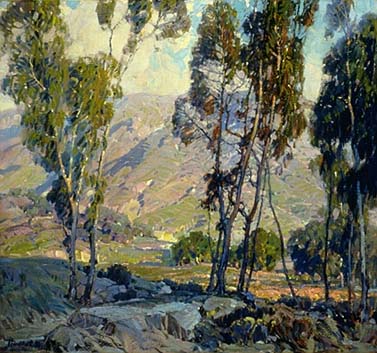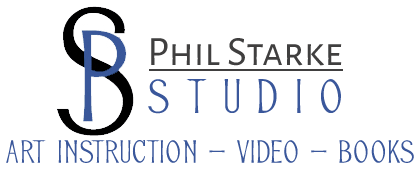Category Archives for Book Reviews
The Artist’s Handbook – Slow Down the Drying Time of Oil Paint


Usually, if I’m trying to alter the drying time of oils, it’s to speed it up to meet a deadline or to make changes over dry paint. But once in a while, like in portraiture or figure painting, it’s nice to slow down the drying time to achieve subtle changes over a longer period of time. Oil of Cloves is one way of slowing the drying time. It’s a preservative that’s used to cover up the odor of decomposition. It has a pretty strong odor but it’s tolerable. A few drops in a paint mixture retards the drying time. Ralph Mayers’ book The Artist’s Handbook of Materials and Techniques: Fifth Edition on materials talks about other ways of retarding color as well as answering every question you ever had about artists materials. It’s an exhaustive manual on techniques old and new as well as supplies and materials.
New “Book Shelf” on Starke Studio Website
 A new website feature has been added to StarkeStudio.com. I’ve created a “Book Shelf” of my favorite and highly recommended books for both students and collectors. To be a good artist or good collector it requires more than just picking up a brush and starting a painting, or just going to any art gallery and buying any painting. Whether you’re a creator or collector, to be better at either, you should be studying. In art school it was mandatory to study other artists even though we were getting direct instruction and painting every day. So along with studying with me, I always encourage my students to go through books and study other artists and visiting galleries and museums to see the artwork up close. For collectors, studying provides you with the understanding of the artist, what is or was their approach to painting, their history and background, and what their place is or was in the world of art. All those things allow the collector to make an informed and educated choice when buying artwork. With those thoughts in mind, I’ve selected some of my favorites for both artists and collectors. Sections for both “Art Instruction” and “Art Reference” are included on “The Book Shelf”. I hope you get the chance to create a wonderful Art Library for yourself and enjoy the ability to pass some art knowledge and appreciation on to others. The Book Shelf isn’t complete yet, I’m still adding those items that I think are important additions to any library, but what’s up now will give you a chance to check some things out.
A new website feature has been added to StarkeStudio.com. I’ve created a “Book Shelf” of my favorite and highly recommended books for both students and collectors. To be a good artist or good collector it requires more than just picking up a brush and starting a painting, or just going to any art gallery and buying any painting. Whether you’re a creator or collector, to be better at either, you should be studying. In art school it was mandatory to study other artists even though we were getting direct instruction and painting every day. So along with studying with me, I always encourage my students to go through books and study other artists and visiting galleries and museums to see the artwork up close. For collectors, studying provides you with the understanding of the artist, what is or was their approach to painting, their history and background, and what their place is or was in the world of art. All those things allow the collector to make an informed and educated choice when buying artwork. With those thoughts in mind, I’ve selected some of my favorites for both artists and collectors. Sections for both “Art Instruction” and “Art Reference” are included on “The Book Shelf”. I hope you get the chance to create a wonderful Art Library for yourself and enjoy the ability to pass some art knowledge and appreciation on to others. The Book Shelf isn’t complete yet, I’m still adding those items that I think are important additions to any library, but what’s up now will give you a chance to check some things out.
When Oil Paint Doesn’t Dry Fast Enough
Usually, if I’m trying to alter the drying time of oils, it’s to speed it up to meet a deadline or to make changes over dry paint. But once in a while, like in portraiture or figure painting, it’s nice to flow down the drying time to achieve subtle changes over a longer period of time.
Oil of Cloves is one way of slowing the drying time. It’s a preservative that’s used to cover up the odor of decomposition. It has a pretty strong odor but it’s tolerable. A few drops in a paint mixture retards the drying time. Ralph Meyer’s book “The Artists Handbook of Materials and Techniques”
Hanson Puthoff 1875 – 1972
 Hanson Puthoff
Hanson Puthoff
Hanson was an important figure in the Southern California art scene. He helped form the Continue Reading
Hanson Puthoff 1875 – 1972
 Hanson Puthoff
Hanson Puthoff
Hanson was an important figure in the Southern California art scene. He helped form the Continue Reading
Fundamentals of Painting
 After years of taking and teaching workshops, I’ve come to understand that the fundamentals are important in painting, but are just a means to get you where you want to be with your artwork. As John Carlson says in his book, John Carlson’s Guide to Landscape Painting, “Art is a thing so much of the imagination, of the soul, that it is difficult to descend to the fundamentals of technique and yet make it plain to the student that these are but the means, and not an end in themselves. The underlying principles, or fundamentals, should be so hidden anyway by the beauty that they are eventually to support, that it would require much digging to disclose them.” In other words, Continue Reading
After years of taking and teaching workshops, I’ve come to understand that the fundamentals are important in painting, but are just a means to get you where you want to be with your artwork. As John Carlson says in his book, John Carlson’s Guide to Landscape Painting, “Art is a thing so much of the imagination, of the soul, that it is difficult to descend to the fundamentals of technique and yet make it plain to the student that these are but the means, and not an end in themselves. The underlying principles, or fundamentals, should be so hidden anyway by the beauty that they are eventually to support, that it would require much digging to disclose them.” In other words, Continue Reading

